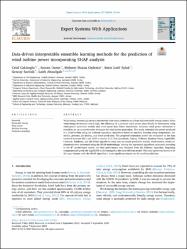Data-driven interpretable ensemble learning methods for the prediction of wind turbine power incorporating SHAP analysis

Göster/
Erişim
info:eu-repo/semantics/openAccessTarih
2023Yazar
Çakıroğlu, CelalDemir, Sercan
Özdemir, Mehmet Hakan
Aylak, Batin Latif
Sariisik, Gencay
Abualigah, Laith
Üst veri
Tüm öğe kaydını gösterKünye
Çakıroğlu, C., Demir, S., Özdemir, Mehmet H., Aylak, Batin L., Sariisik, G., Abualigah, L. (2023). Data-driven interpretable ensemble learning methods for the prediction of wind turbine power incorporating SHAP analysis. 237, 1-12. Elsevier.Özet
Wind energy increasingly attracts investment from many countries as a clean and renewable energy source. Since
wind energy investment cost is high, the efficiency of a potential wind power plant should be determined using
wind power prediction models and wind speed data before installation. Accurate wind power estimation is
crucial to set up comprehensive strategies for wind power generation. This study estimated the power produced
in a wind turbine using six different regression algorithms based on machine learning using temperature, humidity, pressure, air density, and wind speed data. The proposed estimation model was evaluated on the data
received between 2011 and 2020 at station 17,112 in Çanakkale, Turkey. XGBoost, Random Forest, LightGBM,
CatBoost, AdaBoost, and M5-Prime algorithms were used to create predictive models. Furthermore, model explanations were presented using the SHAP methodology. Among the regression algorithms evaluated according
to the R2 performance metric, the best performance was obtained from the XGBoost algorithm. Regarding
computational speed, the LightGBM model emerged as the most efficient model. The wind speed was
















